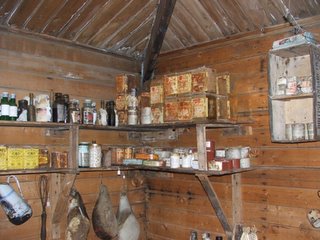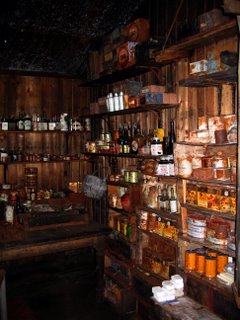





I do believe that the men who first explored this icy cold and forbidding continent are among the toughest men who have ever walked this earth. Some days as I work in the cold I find myself asking, "How did they do it?" I have never known cold like I do here. Some days it is fine but others seem to take your breath away when the wind blows it cuts right through you. The cold seems to be an element that has held certain places untouched for longer than others.
Among the most popular of the explorers are Shackleton, Scott, and Amundsen. Shackleton is famed for his leadership and his strong leadership and ability to keep men alive through the worst of conditions. I just finished reading the book "Endurance" about his failed expedition to the South Pole which ended in the victory of keeping every one of his men alive for almost two years sleeping on drifting icebergs and frozen islands in route to their rescue at a whaling station on South Georgia Island. Alfred Lansing describes that last leg of their voyage to safety.
“The sight that the Caird presented was one of the most incongruous imaginable. Here was a patched and battered 22-foot boat, daring to sail alone across the world’s most tempestuous sea, her rigging festooned with a threadbare collection of clothing and half rotten sleeping bags. Her crew consisted of six men whose faces were black with caked soot and half-hidden by matted beards, who bodies were dead white frm constant soaking in salt water. In addition, their faces, and particularly their fingers were marked with ugly round patches of missing skin where frostbites had eaten into their flesh. There legs from the knees down were chafed and raw from the countless punishing trips crawling across the rocks in the bottom. And all of them were afflicted with salt water boils on their wrists, ankles, and buttocks."
On a later expedition Shackleton and his men spent months here on Ross island within twenty miles of where I live. Scott and Amundsen raced to be the first to reach the South Pole first, but Amundsen reached the Pole first. Scott died on the continent returning from the Pole.
I have seen traces of where these men have walked and come to understand the elements which they stood up against. Scott has two huts close to the station, one less than a mile walk down the peninsula. I have been in this hut and seen empty food boxes, the clothes they wore, the table they made, and even the seal remains from their meals. Everything is almost exactly the way it was when these men left. About fifty years after the Scott expedition on Ross Island men were left near the McMurdo area and they made their way to his hut, surviving by eating well-preserved fifty year-old caches of food from Scott's expedition.
Less than a hundred years ago men came in wooden ships, wearing wool clothing, and using primitive means of mapping in order to explore the most inhospitable place on earth. Today there are no dogs allowed here, people live in dorms, and we have heated buildings. These men amaze me and their huts are time warps that make you feel out-of-place in a common windbreaker and modern boots.
These pictures have all been taken on Ross Island by my friends and I. One is Shackleton's Hut twenty miles away, one is Scott's Hut here on Ross Island, and one is the inside of Shackleton's hut. There is no Museum feeling, and these items aren't behind glass.





 I do believe that the men who first explored this icy cold and forbidding continent are among the toughest men who have ever walked this earth. Some days as I work in the cold I find myself asking, "How did they do it?" I have never known cold like I do here. Some days it is fine but others seem to take your breath away when the wind blows it cuts right through you. The cold seems to be an element that has held certain places untouched for longer than others.
Among the most popular of the explorers are Shackleton, Scott, and Amundsen. Shackleton is famed for his leadership and his strong leadership and ability to keep men alive through the worst of conditions. I just finished reading the book "Endurance" about his failed expedition to the South Pole which ended in the victory of keeping every one of his men alive for almost two years sleeping on drifting icebergs and frozen islands in route to their rescue at a whaling station on South Georgia Island. Alfred Lansing describes that last leg of their voyage to safety.
“The sight that the Caird presented was one of the most incongruous imaginable. Here was a patched and battered 22-foot boat, daring to sail alone across the world’s most tempestuous sea, her rigging festooned with a threadbare collection of clothing and half rotten sleeping bags. Her crew consisted of six men whose faces were black with caked soot and half-hidden by matted beards, who bodies were dead white frm constant soaking in salt water. In addition, their faces, and particularly their fingers were marked with ugly round patches of missing skin where frostbites had eaten into their flesh. There legs from the knees down were chafed and raw from the countless punishing trips crawling across the rocks in the bottom. And all of them were afflicted with salt water boils on their wrists, ankles, and buttocks."
On a later expedition Shackleton and his men spent months here on Ross island within twenty miles of where I live. Scott and Amundsen raced to be the first to reach the South Pole first, but Amundsen reached the Pole first. Scott died on the continent returning from the Pole.
I have seen traces of where these men have walked and come to understand the elements which they stood up against. Scott has two huts close to the station, one less than a mile walk down the peninsula. I have been in this hut and seen empty food boxes, the clothes they wore, the table they made, and even the seal remains from their meals. Everything is almost exactly the way it was when these men left. About fifty years after the Scott expedition on Ross Island men were left near the McMurdo area and they made their way to his hut, surviving by eating well-preserved fifty year-old caches of food from Scott's expedition.
Less than a hundred years ago men came in wooden ships, wearing wool clothing, and using primitive means of mapping in order to explore the most inhospitable place on earth. Today there are no dogs allowed here, people live in dorms, and we have heated buildings. These men amaze me and their huts are time warps that make you feel out-of-place in a common windbreaker and modern boots.
These pictures have all been taken on Ross Island by my friends and I. One is Shackleton's Hut twenty miles away, one is Scott's Hut here on Ross Island, and one is the inside of Shackleton's hut. There is no Museum feeling, and these items aren't behind glass.
I do believe that the men who first explored this icy cold and forbidding continent are among the toughest men who have ever walked this earth. Some days as I work in the cold I find myself asking, "How did they do it?" I have never known cold like I do here. Some days it is fine but others seem to take your breath away when the wind blows it cuts right through you. The cold seems to be an element that has held certain places untouched for longer than others.
Among the most popular of the explorers are Shackleton, Scott, and Amundsen. Shackleton is famed for his leadership and his strong leadership and ability to keep men alive through the worst of conditions. I just finished reading the book "Endurance" about his failed expedition to the South Pole which ended in the victory of keeping every one of his men alive for almost two years sleeping on drifting icebergs and frozen islands in route to their rescue at a whaling station on South Georgia Island. Alfred Lansing describes that last leg of their voyage to safety.
“The sight that the Caird presented was one of the most incongruous imaginable. Here was a patched and battered 22-foot boat, daring to sail alone across the world’s most tempestuous sea, her rigging festooned with a threadbare collection of clothing and half rotten sleeping bags. Her crew consisted of six men whose faces were black with caked soot and half-hidden by matted beards, who bodies were dead white frm constant soaking in salt water. In addition, their faces, and particularly their fingers were marked with ugly round patches of missing skin where frostbites had eaten into their flesh. There legs from the knees down were chafed and raw from the countless punishing trips crawling across the rocks in the bottom. And all of them were afflicted with salt water boils on their wrists, ankles, and buttocks."
On a later expedition Shackleton and his men spent months here on Ross island within twenty miles of where I live. Scott and Amundsen raced to be the first to reach the South Pole first, but Amundsen reached the Pole first. Scott died on the continent returning from the Pole.
I have seen traces of where these men have walked and come to understand the elements which they stood up against. Scott has two huts close to the station, one less than a mile walk down the peninsula. I have been in this hut and seen empty food boxes, the clothes they wore, the table they made, and even the seal remains from their meals. Everything is almost exactly the way it was when these men left. About fifty years after the Scott expedition on Ross Island men were left near the McMurdo area and they made their way to his hut, surviving by eating well-preserved fifty year-old caches of food from Scott's expedition.
Less than a hundred years ago men came in wooden ships, wearing wool clothing, and using primitive means of mapping in order to explore the most inhospitable place on earth. Today there are no dogs allowed here, people live in dorms, and we have heated buildings. These men amaze me and their huts are time warps that make you feel out-of-place in a common windbreaker and modern boots.
These pictures have all been taken on Ross Island by my friends and I. One is Shackleton's Hut twenty miles away, one is Scott's Hut here on Ross Island, and one is the inside of Shackleton's hut. There is no Museum feeling, and these items aren't behind glass.

2 Comments:
incredible briggs. How cool to be that close to Shakelton and crew. Thanks for sharing your experiences there brother. BTW, check out my blog at this link ... I made you a movie.
http://web.mac.com/bradleygwright/iWeb/revwright/mini-blog/mini-blog.html
Alan Briggs, a man with a Shakelton Heart! A warrior for Jesus!
Post a Comment
<< Home